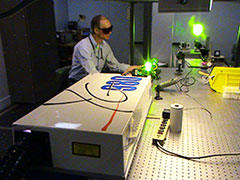
EOVAF scientists set standard for laser vulnerability analysis
Since 1983, the U.S. Army Research Laboratory's (ARL) Survivability/Lethality Analysis Directorate's (SLAD) Electro-Optical Vulnerability Assessment Facility (EOVAF) at White Sands Missile Range, N.M. has provided the resources needed for SLAD to establish preeminence in the field of laser vulnerability analysis. SLAD personnel use... More
TOP ARL STORIES
SLAD advances survivability in under–body blast attacks
"The IED is the weapon of choice for threat networks because they are cheap, made from readily available off-the-shelf components, easy to construct, lethal, and accurate," said Army Lt. Gen. Michael D. Barbero, director of the Joint IED Defeat Organization, in his September 2012 testimony to the House... More

Developing an active approach to defense
For the past decade members of the Army's research community have worked to develop models of an active protection system (APS) with multiple configurations. The goal is to eventually field APS variants on Army vehicles.
Greg Bradley, a member of the U. S. Army Research Laboratory's (ARL) Survivability/Lethality... More

ARL computer systems rank among the world's fastest supercomputers
The U.S. Army Research Laboratory (ARL) was recently recognized on the TOP500 List of the world's top supercomputers.
"ARL's 19-year history of having High Performance Computing (HPC) systems highly ranked in the world's TOP500 Supercomputing Sites list portrays ARL... More

HRED researchers are developing robot intelligence to support Soldiers' missions
Unmanned systems have begun to have a significant impact on warfare. Unmanned drones providing sustained surveillance, swift precise attacks on high value targets and small robots are being used for counter-IED missions. These systems are generally remotely piloted systems and are... More

ARL holds semiannual greening course
For the past few years, the U.S. Army Research Laboratory (ARL) has held courses designed for civilians throughout the organization to learn about and experience the daily activities of its Soldiers. The most recent class was held from Dec. 3-7 at Aberdeen Proving Ground (APG), with some activities conducted at the at the Edgewood Area.... More

Electromagnetic Vulnerability Assessment Facility (EMVAF)
The U.S. Army Research Laboratory (ARL), Survivability/Lethality Analysis Directorate's (SLAD) Electromagnetic Vulnerability Assessment Facility (EMVAF) at the White Sands Missile Range (WSMR) ,New Mexico is a state-of-the-art facility that is used to conduct experiments that address the electromagnetic... More




